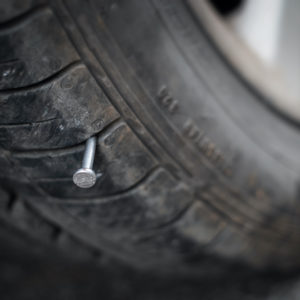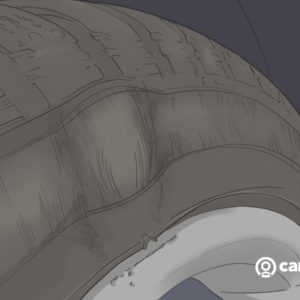Prior to the ’50s, all tires had inner tubes, which were so fraught with problems that flat tires were a common occurrence. Out of necessity, a spare tire and the tools for mounting it became standard equipment on every car and it was the responsibility of all drivers to know how to use them. Although modern improvements in tire design and the advent of “road service” have insulated many drivers from the flat-changing experience, the need to carry a “spare” has not been eliminated. But finally that may be changing…
To automotive engineers, who are continually looking for ways to improve space utilization in new vehicles, the spare tire and associated tools represent space hogs. Certainly the room they take up could be put to better use. And so, various solutions have been proposed, but until now most have met with limited success.
Car makers have attempted to eliminate the spare by providing a small air compressor and an aerosol can of tire sealer. When you have a flat, you can presumably re-inflate the tire while sealing the puncture. Of course, anything larger than a simple puncture and you are in trouble. Other manufacturers have addressed the problem with a type of Run Flat tire that features stiffened sidewalls that allow them to be driven at moderate speeds with no air pressure. But this solution is less than ideal, since the inflexible sidewall can adversely affect ride quality and, in some cases, handling.

Now Michelin has announced a solution to this automotive challenge, which they believe will make the spare tire a thing of the past. In their vision of the future, the only spare tires you will see will be around some people’s waists.
Michelin’s innovation is a new tire system called PAX. It is dubbed a “system” because these tires require a special wheel and an insert in order to work. The wheel is designed to keep the tire on the rim even if all the air is removed and you are driving at 55 miles per hour. The insert prevents the tire from totally collapsing onto the rim.

In the United States, the PAX System is available only on new cars, including the Honda Odyssey Minivan Touring Model and the Rolls Royce Phantom. But the list is growing. In Europe, a number other manufacturers have adopted the PAX system.
The PAX System includes a special wheel and tire that are designed to work together. There is also a support ring that fits around the center of the rim and supports the tire when it is deflated so that the vehicle can be driven. Another part of the system is the combination air valve / pressure detector which reports pressure loss to an indicator on the dash so that the driver knows that there is a problem.

Tires are normally held on the rim with air pressure, but with the PAX System, the tire fits into a special groove in the rim and is locked in place by the shape of the bead, which keeps it secure even when air pressure is lost. It’s a great idea, but how does it work in practice?
Michelin people have been going from city to city with their Continued Mobility Tour to demonstrate their system to the doubting. And their demonstrations are surprisingly convincing. They begin by placing a small explosive charge on the sidewall of a tire. The charge is wired to a button, which is held by a person sitting in the passenger seat. Then, while everyone watches from a safe distance, they drive the vehicle through a zigzag course laid out in a parking lot and, at about 40 mph, they blow out the tire. The noise is loud and startling; yet the vehicle continues unaffected on the course and is able to proceed out of the parking lot, riding for another 60 miles on the flat.
At the Michelin event that I attended, we reporters were then given the opportunity to drive vehicles outfitted with the Run Flat system, half with properly inflated tires, the rest with one tire “flat.” The stability and smoothness of the vehicles with the flat tires was impressive. Sure you could tell the difference, but even with flats, the cars were very controllable on an autocross course where we pushed them to their limits.
By the time we were finished having our fun on the track, the Honda Odyssey with the blown-out tire returned with an additional 60 miles on the clock. We all gathered around to see that the tire was still in one piece (with the exception of the original 2 inch hole in the sidewall) and, in fact, it was capable of continuing for quite a few additional miles.
Once we had confirmed that these tires had no problem running without air, we were ready to scrutinize their everyday performance compared to conventional tires. We had plenty of opportunity to experience these tires under a variety of driving conditions and road surfaces. The ride was comparable to normal high quality tires as was the handling. On the road, the noise levels were on a par with the best tires available for high-end vehicles and I fully expect that the tread life will be comparable to that of conventional tires as well.

So what happens if you own a car with these PAX tires and you get a flat? Where do you take it to be repaired? Michelin has set up service centers around the US, including all 1,000 Honda dealers as well as a number of tire shops. There is a toll free number to call to find the nearest location. Part of the PAX warranty is to replace any PAX wheel-tire system that has a problem with air loss with a brand new package so that you will be quickly on your way, even if it is just a simple puncture.
Will Michelin’s innovation eventually put an end to the spare tire? I can’t say for sure, but this is certainly the most promising solution I have seen so far.
Any information provided on this Website is for informational purposes only and is not intended to replace consultation with a professional mechanic. The accuracy and timeliness of the information may change from the time of publication.















